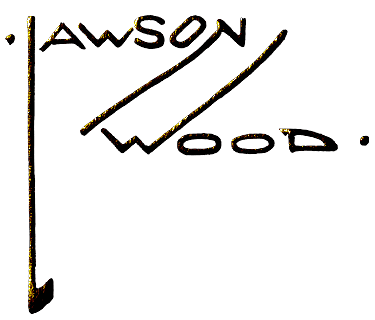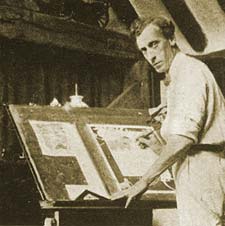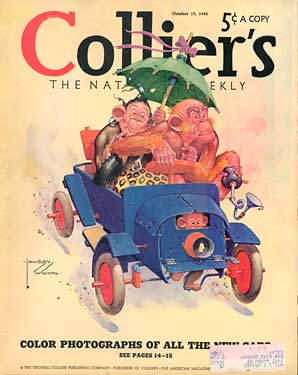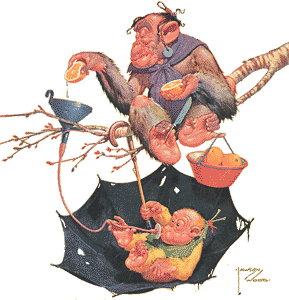


Wood is in #s 1, 5 & 11 of |
 |
 1878-1957 |
| Guest biography courtesy of Jayne Felicity Smith. | ||
 Painter, illustrator and designer:
Lawson Wood was born on 23 August 1878 in Highgate, London to
a family in which watercolor painting had been a tradition for
two generations. He was the grandson of the architectural artist
L.J. Wood RI and eldest son of the landscape painter Pinhorn Wood.
He studied art at the Slade School of Fine Art, Heatherley's School
of Fine Art and attended classes at Frank Calderon's School of
Animal Painting. His humorous, beautifully coloured work is technically
superb and is still enormously collectable today.
Painter, illustrator and designer:
Lawson Wood was born on 23 August 1878 in Highgate, London to
a family in which watercolor painting had been a tradition for
two generations. He was the grandson of the architectural artist
L.J. Wood RI and eldest son of the landscape painter Pinhorn Wood.
He studied art at the Slade School of Fine Art, Heatherley's School
of Fine Art and attended classes at Frank Calderon's School of
Animal Painting. His humorous, beautifully coloured work is technically
superb and is still enormously collectable today.
In 1896 at the age of eighteen he joined the staff of periodical publisher C. Arthur Pearson Ltd. He worked there for six years and it was there that he met his future wife, Charlotte Forge whom he married in 1902. At the age of 24 he pursued a freelance career, which would prove to be extraordinarily successful. He was published in some of the most prestigeous magazines of the day. These would eventually include The Graphic, The Strand Magazine, Punch, The Illustrated London News and Boys Own Paper. He also illustrated a number of books, including The Invaders by Louis Tracy in 1901 for Pearson.
 |
| image courtesy of lawson-wood-prints.com |
 By 1906 his comic style was at
its best; clean-lined and colourful and his sense of humour sharp
and observant. It was in this year and in those immediately following
that he produced some of his most impressive work. Lawson Wood's
popularity and his reputation as a leading comic artist were well
established. He was especially noted for his "prehistoric"
humor that paired stone age humans with caricatures of dinosaurs,
like the 1903 example above (which appeared in the 1905 Printer's
Pie in duotone). When the noted art instructor Percy V. Bradshaw
created The Art of the Illustrator (a collection of 20
portfolios showing six stages of a single painting or drawing
by 20 different artists), Wood was chosen to lead off the series—an indication of his standing in the artistic community. The
final stage of his painting, "Ring Time" is at right.
By 1906 his comic style was at
its best; clean-lined and colourful and his sense of humour sharp
and observant. It was in this year and in those immediately following
that he produced some of his most impressive work. Lawson Wood's
popularity and his reputation as a leading comic artist were well
established. He was especially noted for his "prehistoric"
humor that paired stone age humans with caricatures of dinosaurs,
like the 1903 example above (which appeared in the 1905 Printer's
Pie in duotone). When the noted art instructor Percy V. Bradshaw
created The Art of the Illustrator (a collection of 20
portfolios showing six stages of a single painting or drawing
by 20 different artists), Wood was chosen to lead off the series—an indication of his standing in the artistic community. The
final stage of his painting, "Ring Time" is at right.
Lawson Wood signed his work in several different ways. There are at least three different examples of the signature that were employed as his career developed. In his earlier work he used only the initials LW. He also used an elongated L with a dot in front. The dot symbolised the Christian name Clarence, understood to have been hated by Wood and abandoned by him at an early age.
 An active member of the London
Sketch Club, Lawson Wood was a close friend of one of its most
famous and well-loved members, Tom Browne. The time of his membership
in the early days of the century was his madcap Bohemian period,
when the influence of fellow Sketch Club members, in particular
Browne, is evident. It has also come to be recognised as his golden
period artistically.
An active member of the London
Sketch Club, Lawson Wood was a close friend of one of its most
famous and well-loved members, Tom Browne. The time of his membership
in the early days of the century was his madcap Bohemian period,
when the influence of fellow Sketch Club members, in particular
Browne, is evident. It has also come to be recognised as his golden
period artistically.
Lawson Wood was elected a member of the Royal Institute of Painters in Watercolours and showed prolifically with Walker's Galleries and Brook Street Art Gallery and also at the Royal Academy.
During the First World War, Lawson Wood served as an officer in the Kite Balloon Wing of the Royal Flying Corps engaged in one of the war's most dangerous tasks—plane spotting from a balloon. This he undertook with gallantry. Indeed, the French decorated him for his action over Vimy Ridge. Despite his active service, Wood continued to draw, and Dobson Molle & Co. published the patriotic designs he produced during the war.
Once peace returned, Lawson Wood's love of animals came to the fore in his work. To ensure accuracy of detail, Lawson Wood regularly visited London Zoo and a small menagerie in Eastbourne, The Wannock Tea Garden. Inter-Art and Valentine published many of his designs. He also set up a factory producing "The Lawson Woodies" simple wooden toys of animals, birds and humans to his own designs.
 Lawson Wood gained immense popularity
with his humorous drawings of comic policemen, dinosaurs, prehistoric
and Stone Age characters, and apes and monkeys often seen performing
absurd antics against immaculate, dead-pan backgrounds. Eventually
Gran'pop, the artful ginger ape (see sample at right from
the cover of one of the Gran'pop's Annuals and also used
on the cover of the September 30, 1939 issue of Collier's),
and the rest of the chimpanzee family were to bring him fame on
both sides of the Atlantic. The Gran'pop's Annuals were a yearly
excursion into comic absurdities that were popular around the
world. Cartoons were made featuring these characters and, but
for the outbreak of World War Two, would have been turned into
an animated film by Ub Iwerks' studio in Hollywood.
Lawson Wood gained immense popularity
with his humorous drawings of comic policemen, dinosaurs, prehistoric
and Stone Age characters, and apes and monkeys often seen performing
absurd antics against immaculate, dead-pan backgrounds. Eventually
Gran'pop, the artful ginger ape (see sample at right from
the cover of one of the Gran'pop's Annuals and also used
on the cover of the September 30, 1939 issue of Collier's),
and the rest of the chimpanzee family were to bring him fame on
both sides of the Atlantic. The Gran'pop's Annuals were a yearly
excursion into comic absurdities that were popular around the
world. Cartoons were made featuring these characters and, but
for the outbreak of World War Two, would have been turned into
an animated film by Ub Iwerks' studio in Hollywood.
Recognition was not limited to the artistic world: in 1934 he was awarded a fellowship of the Royal Zoological Society for his active work with animals and their welfare. He set up his own animal sanctuary for aged creatures.
Towards the end of his life he lived as something of a recluse
in a 15th century medieval manor house which he discovered in
the heart of Sussex and which he moved brick by brick to the loveliest
part of the Kent and Sussex borders. He died there on 26 October
1957 at the age of 79.
Thanks again to Jayne Felicity Smith of Guggenheim Pictorials for providing this biography.
 To learn more about Lawson Wood, see:
To learn more about Lawson Wood, see:| Brush Pen and Pencil: The Book of Lawson Wood | A.E. Johnson, Adam & Charles Black 1910 |
| The Dictionary of British Book Illustrators and Caricaturists 1800-1914 | Simon Houfe, Antique Collectors' Press 1978/1981 |
| The Vadeboncoeur Collection of Knowledge | Jim Vadeboncoeur, Jr. 2001 |
| The Vadeboncoeur Collection of ImageS 1, 5, 11 | Jim Vadeboncoeur, Jr. JVJ Publishing 2002, 2003, 2009 |
| Illustrations are copyright by their respective owners. Text written and © by Jayne Felicity Smith and Jim Vadeboncoeur, Jr. Page is designed & © 2003 by Jim Vadeboncoeur, Jr. |
